Australia has almost 900,000km of sealed and unsealed roads that carry billions of tonnes of freight and billions of passenger trips.
Story Bruce McMahon Photo Charles Davis
For all the bulldust, all the long hauls of tar and the scarcity of water, there is one major obstacle maintaining roads in Bulloo Shire, in south-western Queensland. “Our biggest headache is getting money for the bloody things,” says long-time Bulloo mayor John ‘Tractor’ Ferguson.
Roads are staple business for the Thargomindah-based council, 1,000km west of Brisbane. The 74,000sq km shire – taking in Cameron Corner and the Burke and Wills Dig Tree – borders SA to the west and NSW to the south. “Our core thing is roads – maintenance of roads,” Tractor says. “There are about 3,000km and we can’t maintain it all because we don’t have the money. Our rural rates are about $1 million, town rates are nothing – won’t even run the swimming pool. We generate only about 15% in revenue and the rest is grants: some federal, some state. We have oilfields in our backyard and if it wasn’t for them we’d probably be struggling. They pay their way and they’re good to the community.”
In 2019–20, national road spending – by federal, state and local governments – totalled more than $29 billion. Local governments are responsible for more than 75% of roads, spending close to $9 billion a year on new and existing infrastructure. Some of that bill is paid by rates, some by states, and federal funds and grants.
About 800–900km of Bulloo Shire’s network is sealed, with an 8m wide bitumen road out here costing an estimated $450,000 per kilometre. Much of that bitumen is state road. Depending on traffic volumes, some gravel roads need a grade at least once a year and wet weather here can close side tracks or cattle station roads for months. And bitumen roads still need attention. “The thing is, once you put bitumen roads down, you’ve got to maintain them,” Tractor says. “Reseal them every seven years. You may get away with them a bit longer, depending on the traffic. Although the more traffic, the better – that keeps the bitumen working all the time.”
Back in the day, Tractor was a shire grader driver. Today, he wishes politicians and bureaucrats on the coast would better understand what remote councils face with roadworks and maintenance. “I think one thing, to be fair, if they’d just make the effort to come out, once a year. Have a look and see what we put up with. You know we whinge and whine a bit, but chuck us a few dollars and we’d probably shut up.”
Tractor is passionately chasing dollars to seal a 148km stretch between Thargomindah and the NSW border to see an all-weather inland route from Adelaide through to Brisbane. He says this could be an alternative national highway connecting the north to the south and across to Perth. “Little communities would start working again, get more people coming out, more businesses popping up. So everything’s not stuck on the coast.”
This story excerpt is from Issue #143
Outback Magazine: June/July 2022










